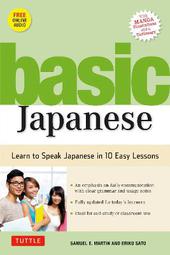
|
Basic Japanese: Learn to Speak Japanese in 10 Easy Lessons (Fully Revised and Expanded with Manga Illustrations, Audio Downloads
Paperback / softback
Main Details
| Title |
Basic Japanese: Learn to Speak Japanese in 10 Easy Lessons (Fully Revised and Expanded with Manga Illustrations, Audio Downloads
|
| Authors and Contributors |
By (author) Samuel E. Martin
|
|
By (author) Eriko Sato
|
| Physical Properties |
| Format:Paperback / softback | | Pages:384 | | Dimensions(mm): Height 229,Width 152 |
|
| ISBN/Barcode |
9784805313909
|
| Classifications | Dewey:495.682421 |
|---|
| Audience | |
|---|
| Edition |
Revised, Paperback with disc
|
| Illustrations |
includes online Audio; Manga Illustrations; Englis
|
|
Publishing Details |
| Publisher |
Tuttle Publishing
|
| Imprint |
Tuttle Publishing
|
| Publication Date |
14 November 2017 |
| Publication Country |
United States
|
Description
This best-selling Japanese textbook is a user-friendly guide for beginners designed for use in a classroom or for self-study. It adopts a very different approach from other Japanese language books-teaching you the underlying sentence structures and patterns of Japanese along with key vocabulary and phrases so you can attain basic fluency quickly. The emphasis is on acquiring a working knowledge of simple, everyday Japanese sentences. This new edition has been thoroughly updated and expanded to reflect the way Japanese is actually spoken in Japan today. Manga illustrations have been added for each dialogue along with the latest jargon for Internet, social media, cellphones and IT, and a bidirectional dictionary is included at the back. Each self-contained lesson presents a simple four-step method: Step 1: Basic Sentences: Each lesson begins with a few simple sentences. Key vocabulary and phrases are learned within the context of these sentences. Audio recordings by native speakers are in the free CD-ROM in the book. Step 2: Communication Notes: A detailed discussion of each sentence follows, to assist you in understanding the underlying structure and how to form new sentences based on the same pattern. Step 3: Everyday Conversations: Authentic dialogues with manga illustrations and native-speaker recordings show you how people communicate naturally in Japan today through simple, everyday interactions. Step 4: Exercises: Several sets of easy exercises help reinforce your understanding of the key points presented in the lesson and review what you have learned so you can move on to the next lesson.
Author Biography
Samuel E. Martin was a master teacher of the Japanese language and a major force in language learning in the postwar U.S. He received his undergraduate and master's degrees in oriental languages from the University of California at Berkeley and his Ph.D. in linguistics from Yale University. At Yale he served as chairman of the Department of East and South Asian Languages and Literatures and the Department of Linguistics. He is the author of numerous books and papers on Japanese and Korean, including the definitiveA Reference Grammar of Japanese and A Reference Grammar of Korean. Eriko Sato is Associate Professor of Japanese and translation studies at the State of University of New York at Stony Brook, where she is also the Director of the Japanese Teacher Education Program. She has authored and co-authored over a dozen books, including Japanese Stories for Language Learners, Essential Japanese Grammar and Learning Japanese Kanji. She has also authored or co-authored Contemporary Japanese, Japanese Demystified, Japanese for Dummies, Complete Japanese Grammar, Japanese Phrases for Dummies, Basic Japanese and My First Japanese Kanji Book.
Reviews"Verbs are usually the key to understanding a sentence or part of a text, so it's well worth emphasising them ... If you know these 600 verbs that's really going to help unlock a lot of Japanese for you.'" --How to Japan blog "This book excels at differentiating really similar concepts, even adding more to the never-ending question of 'What is the difference between [this character] and [this character]?' The vocabulary words are also thematically arranged, usually with illustrations for some words for better memory reinforcement. Pronunciation in the CD tracks actually sounds natural compared to other learning materials" --Japan Reference blog
|